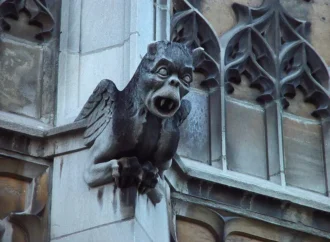Donald Trump in recent days has repeatedly attacked the city of Baltimore for its very low quality of life, denouncing it as “rodent-infested” and noting it has a very, very high homicide rate.
It’s difficult to find reliable stats on Baltimore’s rodent population per capita, but we can consult the FBI crime data on Baltimore’s homicide rate. When it comes to Baltimore being a haven of appalling violent crime, Trump’s not wrong.
The most recent homicide data from the FBI (2017) shows the city of Baltimore with a homicide rate of 55.8 per 100,000 population.That’s a homicide rate comparable to El Salvador (60 per 100,000) and Venezuela (56 per 100,000). Baltimore has more homicides per capita than Honduras, Guatemala, South Africa, and Brazil.
In other words, Baltimore’s homicide problem is worse than those in many of the world’s most violent countries.
In contrast, the US homicide rate in 2017 was 5.3 per 100,000 making Baltimore homicide rate ten times larger than that in the US overall.

Moreover, the gap between the US homicide rate and the Baltimore homicide rate has gotten worse over the past decade. The US rate has fallen since 2007, but it has gone up significantly in Baltimore over that time.
This gap also helps to illustrate the absurdity of referring to a “America’s homicide problem,” when the overwhelming majority of Americans live in places with homicide rates that are a small fraction of the places known for frequent killings.
For examples, if we look at homicide rate in metropolitan Baltimore, but remove homicides from the core city, we find the homicide rate was 3.5 per 100,000 in 2017. That makes metro Baltimore – excluding the core city – one of the safest places in the Western hemisphere, similar to that of Manitoba or Saskatchewan in Canada.

Gun Control Failed
Not coincidentally, Baltimore is located in a state which “boasts” of having some of the nation’s most stringent gun laws.
According to the pro-gun-control Giffords Center, Maryland is the “fourth strongest” in terms of gun restrictions.
These restrictions were substantially strengthened in 2013 with the adoption of the Firearms Safety Act of 2013. But, as researcher Brian Bissett has noted, shooting deaths in Baltimore increased significantly after 2013, even as the population decreased:
Shootings were TRENDING DOWNWARD and Population loss was leveling off in Baltimore City prior to the Passage of the FIREARMS SAFETY ACT OF 2013 …
In 2015, DEATHS by SHOOTINGS in Baltimore City roughly doubled and have not fallen since. Baltimore has on average 275 to 300 people shot to death each year, up from about 150 to 175 prior to the passage of the FIREARMS SAFETY ACT OF 2013. Population flight from the City of Baltimore has also resumed as people are fleeing from the sharp increase in violence permeating every area of Baltimore City.” [emphasis in original.]
The Need for Self-Protection in Baltimore
The penchant for increasing gun control restrictions in Baltimore is especially tragic considering the fact that residents have no reason to believe the police are doing much to rid the city of murderers.
In 2017, for example, the “clearance rate” for homicides in Baltimore was just 27 percent. That is, Baltimore police only made arrests or otherwise “solved” homicide cases less than one-third of the time. 2018’s clearance rate increased to 50 percent, but clearance rates only reflect arrests. They don’t mean the police found the right person, and they don’t mean a suspect was successfully prosecuted in court.
Thus, it’s not outlandish to conclude that if you murder someone in Baltimore, you’ll probably get away with it.
Under conditions like these, it becomes increasingly clear why there’s a correlation between gun control and rising homicides. Personal ownership of a firearm may very well be the only thing a person can rely on a defense against being a victim of homicide.
Moreover, since the legal system is of little use, homicide spirals such as those in Baltimore illustrate a deadly problem in cities across the country: Systemic failure to solve gun crimes fuels widening cycles of violence, leaving shooters free to strike again, eroding trust in the police, and driving some victims to seek their own justice.1
Of course, there are things the police could do to increase their effectiveness.
For example, in a study by B. Forst, J. Lucianovic, and S. J. Cox, the authors
discovered that officers with the most arrests and convictions commonly responded most rapidly to calls for service, were better crime scene managers, were best at identifying, locating, and questioning witnesses, and displayed more of the characteristics commonly identified as relevant to successful investigators. In addition, Forst discovered that cases in which an arrest was made within 30 minutes after the case was reported had the highest chance of resulting in a conviction.
Moreover, studies have shown that other effective strategies include assigning more detectives to homicide cases. But in Baltimore, the police “had 57 homicide detectives assigned to 483 cases. The Citywide Shooting Unit had just 26 detectives for 703 cases.” This means the city – which employs approximately 2,600 police officers – devotes less than three percent of its police officers to homicide investigations.
As in most cities, the city government claims it just doesn’t have enough money. Never mind, of course, that public safety is supposed to be the number-one job of civil government. But while homicides reach new highs, city politicians are busy debating “zero waste plans ” and how to shut down garbage incinerators – plans which only cost the city more money. The city’s “Gun Task Force ” was found to be robbing people. The city’s most recent mayor was on the take.
But the city apparently chooses to fritter away its time and resources on issues other than public safety. Moreover, it appears the resources that are devoted to policing are used mostly to make arrests for small-time offenses.
If this is the case, this would simply make Baltimore’s police department like a great many other law enforcement agencies that rarely focus on violent crime.
According to the Vera Institute of Justice, “fewer than five percent” of arrests
are for serious violent crimes. Instead, the bulk of police work is in response to incidents that are not criminal in nature and the majority of arrests involve non-serious offenses like “drug abuse violations”—arrests for which increased more than 170 percent between 1980 and 2016—disorderly conduct, and a nondescript low-level offense category known as “all other non-traffic offenses.”
These offenses are behind 80 percent of all arrests.
Put a little differently: criminologist Victor Kappeler concludes that per capita, police make 14 arrests per year. But, “less than one of these arrests would have been for a violent crime and fewer than two arrests would have been for property crimes. In fact, 12 of the arrests made by our ‘average’ police officer would have been for petty crimes like minor drug or alcohol possession, disorderly conduct, and vandalism.”
Considering all of this, it’s difficult to see how the current problems in Baltimore can be solved easily without major changes in how the police do business and how the city spends its money. The police are already viewed by the residents (with good reason) as too incompetent and corrupt to be of much use in addressing the violent crime problems. So residents do little to provide police with important information in finding violent offenders. Crime then continues to spiral out of control.
Meanwhile, the city government plays the victim, pretending there are no resources to increase public safety, and acting as if the taxpayers should be willing to pay even more. It’s not hard to understand why the city’s population continues to fall.
—
This article has been republished with the permission of the Mises Institute.
[Image Credit: Flickr-Office of Public Affairs, CC BY 2.0]
















Leave a Comment
Your email address will not be published. Required fields are marked with *